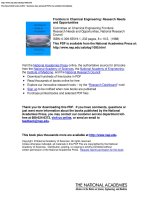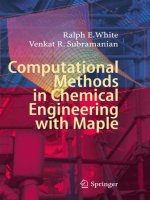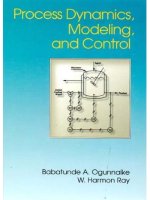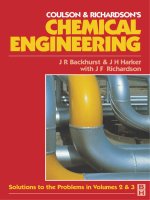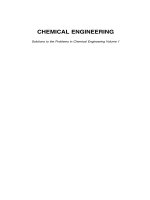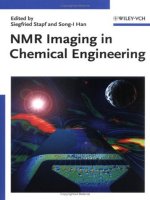coulson & richardson - solutions to the problems in chemical engineering volume 2 & 3
Bạn đang xem bản rút gọn của tài liệu. Xem và tải ngay bản đầy đủ của tài liệu tại đây (2.95 MB, 353 trang )
CHEMICAL ENGINEERING
Solutions to the Problems in Chemical Engineering
Volumes 2 and 3
Related Butterworth-Heinemann Titles in the Chemical Engineering Series by
J. M. COULSON & J. F. RICHARDSON
Chemical Engineering, Volume 1, Sixth edition
Fluid Flow, Heat Transfer and Mass Transfer
(withJ.R.BackhurstandJ.H.Harker)
Chemical Engineering, Volume 3, Third edition
Chemical and Biochemical Reaction Engineering, and Control
(edited by J. F. Richardson and D. G. Peacock)
Chemical Engineering, Volume 6, Third edition
Chemical Engineering Design
(R.K.Sinnott)
Chemical Engineering, Solutions to Problems in Volume 1
(J. R. Backhurst, J. H. Harker and J. F. Richardson)
Chemical Engineering, Solutions to Problems in Volume 2
(J. R. Backhurst, J. H. Harker and J. F. Richardson)
Coulson & Richardson’s
CHEMICAL ENGINEERING
J. M. COULSON and J. F. RICHARDSON
Solutions to the Problems in Chemical Engineering
Volume 2 (5th edition) and Volume 3 (3rd edition)
By
J. R. BACKHURST and J. H. HARKER
University of Newcastle upon Tyne
With
J. F. RICHARDSON
University of Wales Swansea
OXFORD AMSTERDAM BOSTON LONDON NEW YORK PARIS
SAN DIEGO SAN FRANCISCO SINGAPORE SYDNEY TOKYO
Butterworth-Heinemann
An imprint of Elsevier Science
Linacre House, Jordan Hill, Oxford OX2 8DP
225 Wildwood Avenue, Woburn, MA 01801-2041
First published 2002
Copyright
2002, J.F. Richardson and J.H. Harker. All rights reserved
The right of J.F. Richardson and J.H. Harker to be identified as the authors of this work
has been asserted in accordance with the Copyright, Designs
and Patents Act 1988
No part of this publication may be
reproduced in any material form (including
photocopying or storing in any medium by electronic
means and whether or not transiently or incidentally
to some other use of this publication) without the
written permission of the copyright holder except
in accordance with the provisions of the Copyright,
Designs and Patents Act 1988 or under the terms of a
licence issued by the Copyright Licensing Agency Ltd,
90 Tottenham Court Road, London, England W1T 4LP.
Applications for the copyright holder’s written permission
to reproduce any part of this publication should be
addressed to the publishers
British Library Cataloguing in Publication Data
A catalogue record for this book is available from the British Library
Library of Congress Cataloguing in Publication Data
A catalogue record for this book is available from the Library of Congress
ISBN 0 7506 5639 5
For information on all Butterworth-Heinemann publications visit our website at www.bh.com
Contents
Preface vii
Preface to the Second Edition of Volume 5 ix
Preface to the First Edition of Volume 5 xi
Factors for Conversion of SI units xiii
Solutions to Problems in Volume 2
2-1 Particulate solids 1
2-2 Particle size reduction and enlargement 8
2-3 Motion of particles in a fluid 14
2-4 Flow of fluids through granular beds and packed columns 34
2-5 Sedimentation 39
2-6 Fluidisation 44
2-7 Liquid filtration 59
2-8 Membrane separation processes 76
2-9 Centrifugal separations 79
2-10 Leaching 83
2-11 Distillation 98
2-12 Absorption of gases 150
2-13 Liquid–liquid extraction 171
2-14 Evaporation 181
2-15 Crystallisation 216
2-16 Drying 222
2-17 Adsorption 231
2-18 Ion exchange 234
2-19 Chromatographic separations 235
Solutions to Problems in Volume 3
3-1 Reactor design — general principles 237
3-2 Flow characteristics of reactors — flow modelling 262
3-3 Gas–solid reactions and reactors 265
3-4 Gas–liquid and gas–liquid–solid reactors 271
v
3-5 Biochemical reaction engineering 285
3-7 Process control 294
(Note: The equations quoted in Sections 2.1–2.19 appear in Volume 2 and those in
Sections 3.1–3.7 appear in Volume 3. As far as possible, the nomenclature used in this
volume is the same as that used in Volumes 2 and 3 to which reference may be made.)
vi
Preface
Each of the volumes of the Chemical Engineering Series includes numerical examples to
illustrate the application of the theory presented in the text. In addition, at the end of each
volume, there is a selection of problems which the reader is invited to solve in order to
consolidate his (or her) understanding of the principles and to gain a better appreciation
of the order of magnitude of the quantities involved.
Many readers who do not have ready access to assistance have expressed the desire for
solutions manuals to be available. This book, which is a successor to the old Volume 5, is
an attempt to satisfy this demand as far as the problems in Volumes 2 and 3 are concerned.
It should be appreciated that most engineering problems do not have unique solutions,
and they can also often be solved using a variety of different approaches. If therefore the
reader arrives at a different answer from that in the book, it does not necessarily mean
that it is wrong.
This edition of the Solutions Manual which relates to the fifth edition of Volume 2 and
to the third edition of Volume 3 incorporates many new problems. There may therefore
be some mismatch with earlier editions and, as the volumes are being continually revised,
they can easily get out-of-step with each other.
None of the authors claims to be infallible, and it is inevitable that errors will occur
from time to time. These will become apparent to readers who use the book. We have
been very grateful in the past to those who have pointed out mistakes which have then
been corrected in later editions. It is hoped that the present generation of readers will
prove to be equally helpful!
J. F. R.
vii
Preface to the Second Edition
of Volume 5
ITIS always a great joy to be invited to prepare a second edition of any book and on
two counts. Firstly, it indicates that the volume is proving useful and fulfilling a need,
which is always gratifying and secondly, it offers an opportunity of making whatever
corrections are necessary and also adding new material where appropriate. With regard
to corrections, we are, as ever, grateful in the extreme to those of our readers who have
written to us pointing out, mercifully minor errors and offering, albeit a few of what
may be termed ‘more elegant solutions’. It is important that a volume such as this is as
accurate as possible and we are very grateful indeed for all the contributions we have
received which, please be assured, have been incorporated in the preparation of this new
edition.
With regard to new material, this new edition is now in line with the latest edition,
that is the Fourth, of Volume 2 which includes new sections, formerly in Volume 3 with,
of course, the associated problems. The sections are: 17, Adsorption; 18, Ion Exchange;
19, Chromatographic Separations and 20, Membrane Separation Processes and we are
more than grateful to Professor Richardson’s colleagues at Swansea, J. H. Bowen, J.
R. Conder and W. R. Bowen, for an enormous amount of very hard work in preparing
the solutions to these problems. A further and very substantial addition to this edition
of Volume 5 is the inclusion of solutions to the problems which appear in Chemical
Engineering, Volume 3 — Chemical & Biochemical Reactors & Process Control and again,
we are greatly indebted to the authors as follows:
3.1 Reactor Design — J. C. Lee
3.2 Flow Characteristics of Reactors — J. C. Lee
3.3 Gas–Solid Reactions and Reactors — W. J. Thomas and J. C. Lee
3.4 Gas–Liquid and Gas–Liquid–Solid Reactors — J. C. Lee
3.5 Biological Reaction Engineering — M. G. Jones and R. L. Lovitt
3.6 Process Control — A. P. Wardle
and also of course, to Professor Richardson himself, who, with a drive and enthusiasm
which seems to be getting ever more vigorous as the years proceed, has not only arranged
for the preparation of this material and overseen our efforts with his usual meticulous
efficiency, but also continues very much in master-minding this whole series. We often
reflect on the time when, in preparing 150 solutions for the original edition of Volume 4,
the worthy Professor pointed out that we had only 147 correct, though rather reluctantly
agreed that we might still just merit first class honours! Whatever, we always have and
we are sure that we always will owe him an enormous debt of gratitude.
ix
We must also offer thanks to our seemingly ever-changing publishers for their drive,
efficiency and encouragement and especially to the present staff at Butterworth-Heinemann
for not inconsiderable efforts in locating the manuscript for the present edition which was
apparently lost somewhere in all the changes and chances of the past months.
We offer a final thought as to the future where there has been a suggestion that the titles
Volume 4 and Volume 5 may find themselves hijacked for new textural volumes, coupled
with a proposal that the solutions offered here hitherto may just find a new resting place
on the Internet. Whatever, we will continue with our efforts in ensuring that more and
more solutions find their way into the text in Volumes 1 and 2 and, holding to the view
expressed in the Preface to the First Edition of Volume 4 that ‘ worked examples are
essential to a proper understanding of the methods of treatment given in the various texts’,
that the rest of the solutions are accessible to the widest group of students and practising
engineers as possible.
Newcastle upon Tyne, 1997 J. R. B
ACKHURST
J. H. HARKER
(Note: Some of the chapter numbers quoted here have been amended in the later editions
of the various volumes.)
x
Preface to the First Edition
of Volume 5
INTHE preface to the first edition of Chemical Engineering, Volume 4, we quoted the
following paragraph written by Coulson and Richardson in their preface to the first edition
of Chemical Engineering, Volume 1:
‘We have introduced into each chapter a number of worked examples which we believe
are essential to a proper understanding of the methods of treatment given in the text.
It is very desirable for a student to understand a worked example before tackling
fresh practical problems himself. Chemical Engineering problems require a numerical
answer, and it is essential to become familiar with the different techniques so that the
answer is obtained by systematic methods rather than by intuition.’
It is with these aims in mind that we have prepared Volume 5, which gives our solutions
to the problems in the third edition of Chemical Engineering, Volume 2. The material is
grouped in sections corresponding to the chapters in that volume and the present book is
complementary in that extensive reference has been made to the equations and sources of
data in Volume 2 at all stages. The book has been written concurrently with the revision
of Volume 2 and SI units have been used.
In many ways these problems are more taxing and certainly longer than those in Vol-
ume 4, which gives the solutions to problems in Volume 1, and yet they have considerable
merit in that they are concerned with real fluids and, more importantly, with industrial
equipment and conditions. For this reason we hope that our efforts will be of interest to
the professional engineer in industry as well as to the student, who must surely take some
delight in the number of tutorial and examination questions which are attempted here.
We are again delighted to acknowledge the help we have received from Professors
Coulson and Richardson in so many ways. The former has the enviable gift of providing
the minimum of data on which to frame a simple key question, which illustrates the crux
of the problem perfectly, whilst the latter has in a very gentle and yet thorough way
corrected our mercifully few mistakes and checked the entire work. Our colleagues at the
University of Newcastle upon Tyne have again helped us, in many cases unwittingly, and
for this we are grateful.
Newcastle upon Tyne, 1978 J. R. B
ACKHURST
J. H. HARKER
xi
Factors for conversion of SI units
mass pressure
1 lb 0.454 kg 1 lbf/in
2
6.895 kN/m
2
1 ton 1016 kg 1 atm 101.3 kN/m
2
1 bar 100 kN/m
length 1 ft water 2.99 kN/m
2
1in 25.4mm 1inwater 2.49N/m
2
1 ft 0.305 m 1 in Hg 3.39 kN/m
2
1 mile 1.609 km 1 mm Hg 133 N/m
2
time viscosity
1 min 60 s 1 P 0.1 N s/m
2
1 h 3.6 ks 1 lb/ft h 0.414 mN s/m
2
1 day 86.4 ks 1 stoke 10
−4
m
2
/s
1year 31.5Ms 1ft
2
/h 0.258 cm
2
/s
area mass flow
1in
2
645.2 mm
2
1 lb/h 0.126 g/s
1ft
2
0.093 m
2
1 ton/h 0.282 kg/s
1lb/hft
2
1.356 g/s m
2
volume thermal
1in
3
16,387.1 mm
3
1 Btu/h ft
2
3.155 W/m
2
1ft
3
0.0283 m
3
1 Btu/h ft
2
◦
F 5.678 W/m
2
K
1 UK gal 4546 cm
3
1 Btu/lb 2.326 kJ/kg
1 US gal 3786 cm
3
1 Btu/lb
◦
F 4.187 kJ/kg K
1 Btu/h ft
◦
F 1.731 W/m K
force energy
1 pdl 0.138 N 1 kWh 3.6 MJ
1 lb 4.45 N 1 therm 106.5 MJ
1 dyne 10
−5
N
energy calorific value
1ftlb 1.36J 1Btu/ft
3
37.26 kJ/m
3
1 cal 4.187 J 1 Btu/lb 2.326 kJ/kg
1erg 10
−7
J
1 Btu 1.055 kJ
power density
1 h.p. 745 W 1 lb/ft
3
16.02 kg/m
3
1 Btu/h 0.293 W
SECTION 2-1
Particulate Solids
PROBLEM 1.1
The size analysis of a powdered material on a mass basis is represented by a straight line
from 0 per cent at 1
µm particle size to 100 per cent by mass at 101 µm particle size.
Calculate the surface mean diameter of the particles constituting the system.
Solution
See Volume 2, Example 1.1.
PROBLEM 1.2
The equations giving the number distribution curve for a powdered material are dn/dd = d
for the size range 0–10
µm, and dn/dd = 100,000/d
4
for the size range 10–100 µm
where d is in
µm. Sketch the number, surface and mass distribution curves and calculate
the surface mean diameter for the powder. Explain briefly how the data for the construction
of these curves may be obtained experimentally.
Solution
See Volume 2, Example 1.2.
PROBLEM 1.3
The fineness characteristic of a powder on a cumulative basis is represented by a straight
line from the origin to 100 per cent undersize at a particle size of 50
µm. If the powder
is initially dispersed uniformly in a column of liquid, calculate the proportion by mass
which remains in suspension in the time from commencement of settling to that at which
a40
µm particle falls the total height of the column. It may be assumed that Stokes’ law
is applicable to the settling of the particles over the whole size range.
1
Solution
For settling in the Stokes’ law region, the velocity is proportional to the diameter squared
and hence the time taken for a 40
µm particle to fall a height h mis:
t = h/40
2
k
where k a constant.
During this time, a particle of diameter d
µm has fallen a distance equal to:
kd
2
h/40
2
k = hd
2
/40
2
The proportion of particles of size d which are still in suspension is:
= 1 − (d
2
/40
2
)
and the fraction by mass of particles which are still in suspension is:
=
40
0
[1 − (d
2
/40
2
)]dw
Since dw/dd = 1/50, the mass fraction is:
= (1/50)
40
0
[1 − (d
2
/40
2
)]dd
= (1/50)[d − (d
3
/4800)]
40
0
= 0.533 or 53.3 per cent of the particles remain in suspension.
PROBLEM 1.4
In a mixture of quartz of density 2650 kg/m
3
and galena of density 7500 kg/m
3
,thesizes
of the particles range from 0.0052 to 0.025 mm.
On separation in a hydraulic classifier under free settling conditions, three fractions
are obtained, one consisting of quartz only, one a mixture of quartz and galena, and one
of galena only. What are the ranges of sizes of particles of the two substances in the
original mixture?
Solution
Use is made of equation 3.24, Stokes’ law, which may be written as:
u
0
= kd
2
(ρ
s
− ρ),
where k(= g/18µ) is a constant.
For large galena: u
0
= k(25 × 10
−6
)
2
(7500 − 1000) = 4.06 × 10
−6
k m/s
For small galena: u
0
= k(5.2 × 10
−6
)
2
(7500 − 1000) = 0.176 × 10
−6
k m/s
For large quartz: u
0
= k(25 × 10
−6
)
2
(2650 − 1000) = 1.03 × 10
−6
k m/s
For small quartz: u
0
= k(5.2 × 10
−6
)
2
(2650 − 1000) = 0.046 × 10
−6
k m/s
2
If the time of settling was such that particles with a velocity equal to 1.03 × 10
−6
k m/s
settled, then the bottom product would contain quartz. This is not so and hence the
maximum size of galena particles still in suspension is given by:
1.03 × 10
−6
k = kd
2
(7500 − 1000) or d = 0.0000126 m or 0.0126 mm.
Similarly if the time of settling was such that particles with a velocity equal to 0.176 ×
10
−6
k m/s did not start to settle, then the top product would contain galena. This is not
the case and hence the minimum size of quartz in suspension is given by:
0.176 × 10
−6
k = kd
2
(2650 −1000) or d = 0.0000103 m or 0.0103 mm.
It may therefore be concluded that, assuming streamline conditions, the fraction of
material in suspension, that is containing quartz and galena, is made up of particles of
sizes in the range 0.0103–0.0126 mm
PROBLEM 1.5
A mixture of quartz and galena of a size range from 0.015 mm to 0.065 mm is to be
separated into two pure fractions using a hindered settling process. What is the minimum
apparent density of the fluid that will give this separation? How will the viscosity of the
bed affect the minimum required density?
The density of galena is 7500 kg/m
3
and the density of quartz is 2650 kg/m
3
.
Solution
See Volume 2, Example 1.4.
PROBLEM 1.6
The size distribution of a dust as measured by a microscope is as follows. Convert these
data to obtain the distribution on a mass basis, and calculate the specific surface, assuming
spherical particles of density 2650 kg/m
3
.
Size range (
µm) Number of particles in range (−)
0–2 2000
2–4 600
4–8 140
8–12 40
12–16 15
16–20 5
20–24 2
3
Solution
From equation 1.4, the mass fraction of particles of size d
1
is given by:
x
1
= n
1
k
1
d
3
1
ρ
s
,
where k
1
is a constant, n
1
is the number of particles of size d
1
,andρ
s
is the density of
the particles = 2650 kg/m
3
.
x
1
= 1 and hence the mass fraction is:
x
1
= n
1
k
1
d
3
1
ρ
s
nkd
3
ρ
s
.
In this case:
dn kd
3
nρ
s
x
1 200 5,300,000k 0.011
3 600 42,930,000k 0.090
6 140 80,136,000k 0.168
10 40 106,000,000k 0.222
14 15 109,074,000k 0.229
18 5 77,274,000k 0.162
22 2 56,434,400k 0.118
= 477,148,400k= 1.0
The surface mean diameter is given by equation 1.14:
d
s
= (n
1
d
3
1
)
(n
1
d
2
1
)
and hence:
dn nd
2
nd
3
1 2000 2000 2000
3 600 5400 16,200
6 140 5040 30,240
10 40 4000 40,000
14 15 2940 41,160
18 5 1620 29,160
22 2 968 21,296
= 21,968 = 180,056
Thus: d
s
= (180,056/21,968) = 8.20 µm
This is the size of a particle with the same specific surface as the mixture.
The volume of a particle 8. 20
µm in diameter = (π/6)8.20
3
= 288.7 µm
3
.
4
The surface area of a particle 8.20 µm in diameter = (π × 8.20
2
) = 211.2 µm
2
and hence: the specific surface = (211.2/288.7)
= 0.731
µm
2
/µm
3
or 0.731 × 10
6
m
2
/m
3
PROBLEM 1.7
The performance of a solids mixer was assessed by calculating the variance occurring in
the mass fraction of a component amongst a selection of samples withdrawn from the
mixture. The quality was tested at intervals of 30 s and the data obtained are:
mixing time (s) 30 60 90 120 150
sample variance (−) 0.025 0.006 0.015 0.018 0.019
If the component analysed represents 20 per cent of the mixture by mass and each of the
samples removed contains approximately 100 particles, comment on the quality of the
mixture produced and present the data in graphical form showing the variation of mixing
index with time.
Solution
See Volume 2, Example 1.3.
PROBLEM 1.8
The size distribution by mass of the dust carried in a gas, together with the efficiency of
collection over each size range is as follows:
Size range, (
µm) 0–5 5–10 10–20 20–40 40–80 80–160
Mass (per cent) 10 15 35 20 10 10
Efficiency (per cent) 20 40 80 90 95 100
Calculate the overall efficiency of the collector and the percentage by mass of the emitted
dust that is smaller than 20
µm in diameter. If the dust burden is 18 g/m
3
at entry and
the gas flow is 0.3m
3
/s, calculate the mass flow of dust emitted.
Solution
See Volume 2, Example 1.6.
PROBLEM 1.9
The collection efficiency of a cyclone is 45 per cent over the size range 0–5 µm, 80
per cent over the size range 5–10
µm, and 96 per cent for particles exceeding 10 µm.
5
Calculate the efficiency of collection for a dust with a mass distribution of 50 per cent
0–5
µm, 30 per cent 5–10 µm and 20 per cent above 10 µm.
Solution
See Volume 2, Example 1.5.
PROBLEM 1.10
A sample of dust from the air in a factory is collected on a glass slide. If dust on the slide
was deposited from one cubic centimetre of air, estimate the mass of dust in g/m
3
of air
in the factory, given the number of particles in the various size ranges to be as follows:
Size range (
µm) 0–1 1–2 2–4 4–6 6–10 10–14
Number of particles (−) 2000 1000 500 200 100 40
It may be assumed that the density of the dust is 2600 kg/m
3
, and an appropriate allowance
should be made for particle shape.
Solution
If the particles are spherical, the particle diameter is d m and the density ρ = 2600 kg/m
3
,
then the volume of 1 particle = (π/6)d
3
m
3
, the mass of 1 particle = 2600(π/6)d
3
kg
and the following table may be produced:
Size (µm) 0–1 1–2 2–4 4–6
Number of particles (−) 2000 1000 500 200
Mean diameter (
µm) 0.5 1.5 3.0 5.0
(m) 0.5 × 10
−6
1.5 × 10
−6
3.0 × 10
−6
5.0 × 10
−6
Vo l u m e (m
3
) 6.54 × 10
−20
3.38 × 10
−18
1.41 × 10
−17
6.54 × 10
−17
Mass of one particle (kg) 1.70 × 10
−16
8.78 × 10
−15
3.68 × 10
−14
1.70 × 10
−13
Mass of one particles in
size range (kg) 3.40 ×10
−13
8.78 × 10
−12
1.83 × 10
−11
3.40 × 10
−11
Size (µm) 6–10 10–14
Number of particles (−) 100 40
Mean diameter (
µm) 8.0 12.0
(m) 8.0 ×10
−6
12.0 × 10
−6
Vo l u m e (m
3
) 2.68 × 10
−16
9.05 × 10
−16
Mass of one particle (kg) 6.97 × 10
−13
2.35 × 10
−12
Mass of one particles in
size range (kg) 6.97 × 10
−11
9.41 × 10
−11
6
Total mass of particles = 2.50 × 10
−10
kg.
As this mass is obtained from 1 cm
3
of air, the required dust concentration is given by:
(2.50 ×10
−10
) × 10
3
× 10
6
= 0.25 g/m
3
PROBLEM 1.11
A cyclone separator 0.3 m in diameter and 1.2 m long, has a circular inlet 75 mm in
diameter and an outlet of the same size. If the gas enters at a velocity of 1.5 m/s, at what
particle size will the theoretical cut occur?
The viscosity of air is 0.018 mN s/m
2
, the density of air is 1.3 kg/m
3
and the density
of the particles is 2700 kg/m
3
.
Solution
See Volume 2, Example 1.7.
7
SECTION 2-2
ParticleSizeReduction
and Enlargement
PROBLEM 2.1
A material is crushed in a Blake jaw crusher such that the average size of particle is
reduced from 50 mm to 10 mm, with the consumption of energy of 13.0 kW/(kg/s). What
will be the consumption of energy needed to crush the same material of average size
75 mm to average size of 25 mm:
(a) assuming Rittinger’s Law applies,
(b) assuming Kick’s Law applies?
Which of these results would be regarded as being more reliable and why?
Solution
See Volume 2, Example 2.1.
PROBLEM 2.2
A crusher was used to crush a material with a compressive strength of 22.5MN/m
2
.
Thesizeofthefeedwasminus 50 mm, plus 40 mm and the power required was
13.0 kW/(kg/s). The screen analysis of the product was:
Size of aperture (mm) Amount of product (per cent)
through 6.0 all
on 4.0 26
on 2.0 18
on 0.75 23
on 0.50 8
on 0.25 17
on 0.125 3
through 0.125 5
What power would be required to crush 1 kg/s of a material of compressive strength
45 MN/m
2
from a feed of minus 45 mm, plus 40 mm to a product of 0.50 mm aver-
age size?
8
Solution
A dimension representing the mean size of the product is required. Using Bond’s method
of taking the size of opening through which 80 per cent of the material will pass, a value
of just over 4.00 mm is indicated by the data. Alternatively, calculations may be made
as follows:
Size of
aperture
(mm)
Mean d
1
(mm)
n
1
nd
1
nd
2
1
nd
3
1
nd
4
1
6.00
5.00 0.26 1.3 6.5 32.5 162.5
4.00
3.00 0.18 0.54 1.62 4.86 14.58
2.00
1.375 0.23 0.316 0.435 0.598 0.822
0.75
0.67 0.08 0.0536 0.0359 0.0241 0.0161
0.50
0.37 0.17 0.0629 0.0233 0.0086 0.00319
0.25
0.1875 0.03 0.0056 0.00105 0.00020 0.000037
0.125
0.125 0.05 0.00625 0.00078 0.000098 0.000012
Totals: 2.284 8.616 37.991 177.92
From equation 1.11, the mass mean diameter is:
d
v
= n
1
d
4
1
n
1
d
3
1
= (177.92/37.991) = 4.683 mm.
From equation 1.14, the surface mean diameter is:
d
s
= n
1
d
3
1
n
1
d
2
1
= (37.991/8.616) = 4.409 mm.
From equation 1.18, the length mean diameter is:
d
1
= n
1
d
2
1
n
1
d
1
= (8.616/2.284) = 3.772 mm.
From equation 1.19, the mean length diameter is:
d
1
= n
1
d
1
n
1
= (2.284/1.0) = 2.284 mm.
9
In the present case, which is concerned with power consumption per unit mass, the mass
mean diameter is probably of the greatest relevance. For the purposes of calculation a mean
value of 4.0 mm will be used, which agrees with the value obtained by Bond’s method.
For coarse crushing, Kick’s law may be used as follows:
Case 1:
mean diameter of feed = 45 mm, mean diameter of product = 4 mm,
energy consumption = 13.0 kJ/kg, compressive strength = 22.5N/m
2
In equation 2.4:
13.0 = K
K
× 22.5ln(45/4)
and: K
K
= (13.0/54.4) = 0.239 kW/(kg/s) (MN/m
2
)
Case 2:
mean diameter of feed = 42.5 mm, mean diameter of product = 0.50 mm
compressive strength = 45 MN/m
2
Thus: E = 0.239 × 45 ln(42.5/0.50) = (0.239 × 199.9) = 47.8kJ/kg
or, for a feed of 1 kg/s, the energy required = 47.8kW
.
PROBLEM 2.3
A crusher reducing limestone of crushing strength 70 MN/m
2
from 6 mm diameter average
size to 0.1 mm diameter average size, requires 9 kW. The same machine is used to crush
dolomite at the same output from 6 mm diameter average size to a product consisting of
20 per cent with an average diameter of 0.25 mm, 60 per cent with an average diameter
of 0.125 mm and a balance having an average diameter of 0.085 mm. Estimate the power
required, assuming that the crushing strength of the dolomite is 100 MN/m
2
and that
crushing follows Rittinger’s Law.
Solution
The mass mean diameter of the crushed dolomite may be calculated thus:
n
1
d
1
n
1
d
3
1
n
1
d
4
1
0.20 0.250 0.003125 0.00078
0.60 0.125 0.001172 0.000146
0.20 0.085 0.000123 0.000011
Totals: 0.00442 0.000937
and from equation 1.11:
d
v
= n
1
d
4
1
n
1
d
3
1
= (0.000937/0.00442) = 0. 212 mm.
10
For Case 1:
E = 9.0kW,f
c
= 70.0MN/m
2
,L
1
= 6.0 mm, and L
2
= 0.1mm
and in equation 2.3:
9.0 = K
R
× 70.0[(1/0.1) − (1/6.0)]
or: K
R
= 0.013 kW mm/(MN/m
2
)
For Case 2:
f
c
= 100.0MN/m
2
,L
1
= 6.0mm and L
2
= 0.212 mm
Hence: E = 0.013 × 100.0[(1/0.212) − (1/6.0)]
= 5.9kW
PROBLEM 2.4
If crushing rolls 1 m diameter are set so that the crushing surfaces are 12.5 mm apart
and the angle of nip is 31
◦
, what is the maximum size of particle which should be fed to
the rolls?
If the actual capacity of the machine is 12 per cent of the theoretical, calculate the
throughput in kg/s when running at 2.0 Hz if the working face of the rolls is 0.4 m long
and the feed density is 2500 kg/m
3
.
Solution
See Volume 2, Example 2.2.
PROBLEM 2.5
A crushing mill reduces limestone from a mean particle size of 45 mm to the follow-
ing product:
Size (mm) Amount of product (per cent)
12.5 0.5
7.5 7.5
5.0 45.0
2.5 19.0
1.5 16.0
0.75 8.0
0.40 3.0
0.20 1.0
It requires 21 kJ/kg of material crushed. Calculate the power required to crush the same
material at the same rate, from a feed having a mean size of 25 mm to a product with a
mean size of 1 mm.
11
Solution
The mean size of the product may be obtained thus:
n
1
d
1
n
1
d
3
1
n
1
d
4
1
0.5 12.5 3906 48,828
7.5 7.5 3164 23,731
45.0 5.0 5625 28,125
19.0 2.5 296.9 742.2
16.0 1.5 54.0 81.0
8.0 0.75 3.375 2.531
3.0 0.40 0.192 0.0768
1.0 0.20 0.008 0.0016
Totals: 13,049 101,510
and from equation 1.11, the mass mean diameter is:
d
v
= n
1
d
4
1
n
1
d
3
1
= (101,510/13,049) = 7.78 mm
Kick’s law is used as the present case may be regarded as coarse crushing.
Case 1:
E = 21 kJ/kg,L
1
= 45 mm and L
2
= 7.8 mm.
In equation 2.4:
21 = K
K
f
c
ln(45/7.8)
and: K
K
f
c
= 11.98 kJ/kg
Case 2:
L
1
= 25 mm and L
2
= 1.0 mm.
Thus: E = 11.98 ln(25/1.0)
= 38.6kJ/kg
PROBLEM 2.6
A ball-mill 1.2 m in diameter is run at 0.8 Hz and it is found that the mill is not working
satisfactorily. Should any modification in the condition of operation be suggested?
Solution
See Volume 2, Example 2.3.
12
PROBLEM 2.7
Power of 3 kW is supplied to a machine crushing material at the rate of 0.3 kg/s from
12.5 mm cubes to a product having the following sizes: 80 per cent 3.175 mm, 10 per
cent 2.5 mm and 10 per cent 2.25 mm. What power should be supplied to this machine
to crush 0.3 kg/s of the same material from 7.5 mm cube to 2.0 mm cube?
Solution
The mass mean diameter is calculated thus:
n
1
d
1
n
1
d
3
1
n
1
d
4
1
0.8 3.175 25.605 81.295
0.1 2.5 1.563 3.906
0.1 2.25 1.139 2.563
and from equation 1.11:
d
v
= n
1
d
4
1
n
1
d
3
1
= (87.763/28.307) = 3.1mm
(Using Bond’s approach, the mean diameter is clearly 3.175 mm.)
For the size ranges involved, the crushing may be considered as intermediate and
Bond’s law will be used.
Case 1:
E = (3/0.3) = 10 kW/(kg/s),L
1
= 12.5mm and L
2
= 3.1mm.
Thus in equation 2.5:
q = (L
1
/L
2
) = 4.03 and E = 2C
√
(1/L
2
)(1 −1/q
0.5
)
or: 10 = 2C
√
(1/3.1)(1 −1/4.03
0.5
)
= (2C ×0.568 × 0.502).
Thus: C = 17.54 kW mm
0.5
/(kg/s)
Case 2:
L
1
= 7.5mm,L
2
= 2.0mm and q = (7.5/2.0) = 3.75.
Hence: E = 2 × 17.54(1/2.0)(1 −1/3.75
0.5
)
= (35.08 × 0.707 × 0.484)
= 12.0kJ/kg
For a feed of 0.3 kg/s, the power required = (12.0 × 0.3) = 3.6kW
13

